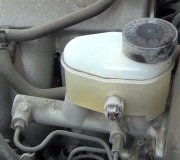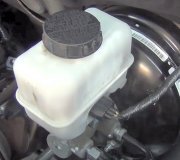Nope. Brake fluid is a glycol product. Engine oil, transmission fluid, and power steering fluid are petroleum-based.
You only need to replace parts that have rubber that comes in contact with the brake fluid. That leaves out the booster, it's vacuum hose, and mechanical things like parking brake cables and brake pads and shoes. What happened to the bladder seal under the reservoir cap is what is happening to all the rubber parts in the hydraulic system. The lip seals in the master cylinder will swell and grow past the fluid return ports. In effect that traps the fluid just as if you were driving while holding the brake pedal down a little.
The parts you'll need to replace include the master cylinder, front calipers, rear wheel cylinders or calipers, all four rubber hoses, and the combination valve, (if you have one), under the master cylinder. Most GM cars have the combination valve built into the master cylinder. It's an extremely low failure rate part that you have to replace as part of the higher failure rate master cylinder. If you have four steel lines coming out of the master cylinder, you don't have to look for a separate combination valve.
At this point the cost of parts isn't too bad unless you live in a road salt state. Often the steel lines will twist off when you try to replace the rubber hoses, but pre-manufactured replacement lines are not real expensive. If you have anti-lock brakes, the hydraulic assembly will have to be replaced because it has rubber seals and o-rings inside. This is an add-on assembly that is bolted to the master cylinder. It's fairly common so you should be able to find a good used one with the master cylinder already attached at most salvage yards.
You can buy rebuilding kits for calipers and wheel cylinders but you won't save much money because rebuilt calipers and new wheel cylinders are so inexpensive today. It doesn't pay to try to rebuild rear calipers because the parking brake is built into the pistons on GM cars and some older Ford products. It is extremely difficult to bleed the air out of them. Also keep in mind that wheel cylinders and calipers are made from cast iron which is porous. In severe situations contamination can leach out of the housings later.
Run brake parts cleaner through the steel brake lines, then blow them out with compressed air. Let them dry completely overnight.
To convince my students how important it was to not work with hydraulic brake parts with greasy fingers, I started my Brakes course with a demonstration. I put about 1/2" of new brake fluid into two beakers and dropped in a wheel cylinder lip seal into each one. In one of them I added a single drop of power steering fluid and mixed it up. After one week I pulled the seals out to show that the contaminated one had grown about 20 percent and was real mushy.
The good news is this is repairable. You'll be spending a lot more for labor than for the parts. It can be done by a competent do-it-yourselfer but there are some tricks professionals use to insure a quality break job. If you plan on attempting this yourself I can provide some pointers that are often overlooked.
Caradiodoc
Friday, February 25th, 2011 AT 8:26 AM



